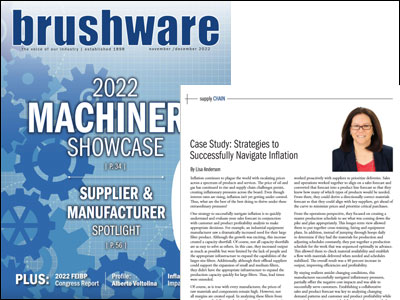As originally published in Brushware Magazine on Sept/ Oct 2022.
Inflation continues to plague the world with escalating prices across a spectrum of products and services. The price of oil and gas has continued to rise and supply chain challenges persist, creating inflationary pressures across the board. Even though interest rates are rising, inflation isn’t yet getting under control. Thus, what are the best of the best doing to thrive under these extraordinary pressures?
One strategy to successfully navigate inflation is quickly understand your sales forecast in conjunction with customer and product profitability and make the appropriate decisions. For example, an industrial equipment manufacturer saw a dramatically increased need for their large filter product. Although exciting growth, this increase created a capacity shortfall. Of course, not all capacity shortfalls are as easy to solve as others. In this case, they increased output as much as possible, but were limited by the lack of people and the appropriate infrastructure to expand the capabilities of the larger size filters. Additionally, although their offload suppliers could support expansion of small and medium filers, they also didn’t have the appropriate infrastructure to expand capacity quickly of large filters. Thus, lead times were extended.
Of course, as is true with every manufacturer, the prices of raw materials and components remain high. However, not all margins are created equal. In analyzing these filters from a product profitability standpoint, they also saw lower margins in comparison to the rest of their product line. Although they would invest in the appropriate infrastructure if it made sense from a strategic standpoint, based on the customer and product profitability analysis, it wouldn’t make sense to prioritize investment in this product line. This analysis propelled the Sales team to re-review large filter orders, customer profitability, priorities, and pricing strategies.
In addition, the company looked at strategies to offset inflationary pressures by getting ahead of demand with suppliers and increasing efficiencies in operations while keeping customer service intact. Since material shortages continued to plague production, they prioritized material forecasts to proactively work with suppliers and prioritize deliveries. Sales and Operations worked together to align on a sales forecast and converted that forecast into a product line forecast so that they knew how many of which types of products would be needed. From there, they could derive a directionally correct materials forecast so that they could align with key suppliers, get ahead of the curve to minimize prices, and prioritize critical purchases.
From the operations perspective, they focused on creating a master production schedule so that they could see what was coming down the pike and plan appropriately. This longer-term view allowed them to put together cross-training, hiring, and equipment plans. In addition, instead of jumping through hoops daily to determine if they had the materials to produce and adjusting schedules constantly, they put together a production schedule for the week that was sequenced optimally in advance. This allowed them to check material availability and establish a flow so that materials were delivered when needed and schedules stabilized. They were able to increase output by 40%, increasing efficiencies and profitability.
By staying resilient with changing conditions, this manufacturer successfully navigated inflationary pressures, partially offset the negative cost impacts and was able to successfully serve customers. Establishing a collaborative sales and product forecast was key to analyzing changing demand patterns and customer and product profitability while proactively managing materials deliveries and operational plans. The company grew substantially and gained marketshare.



